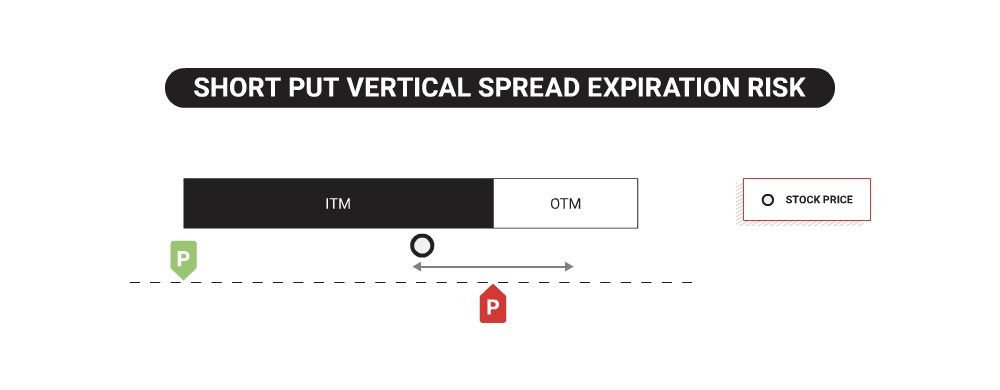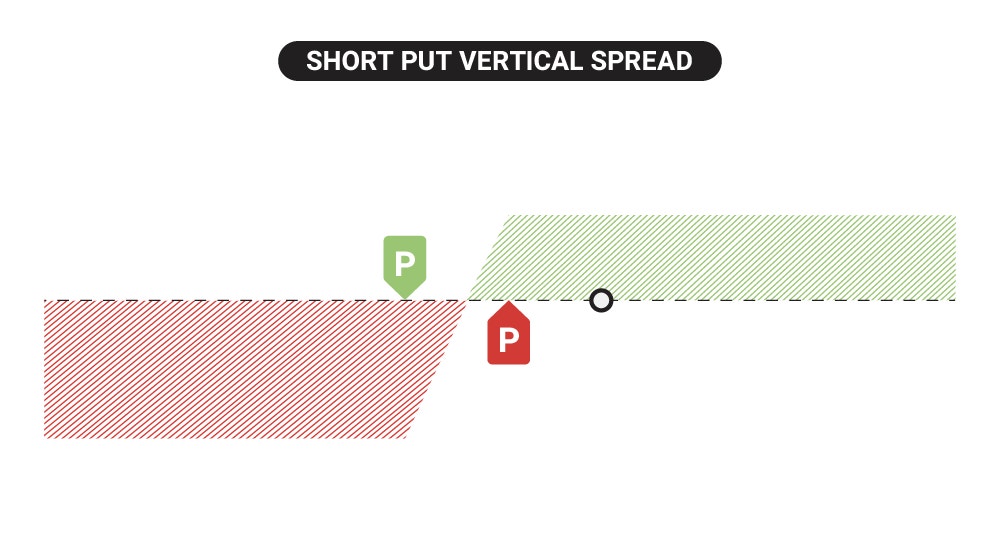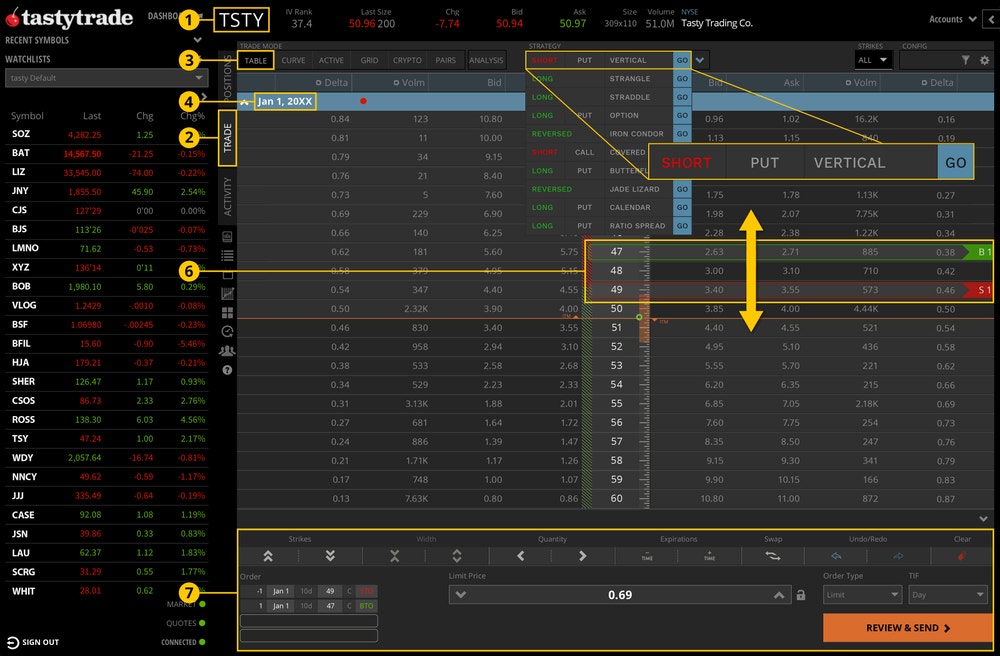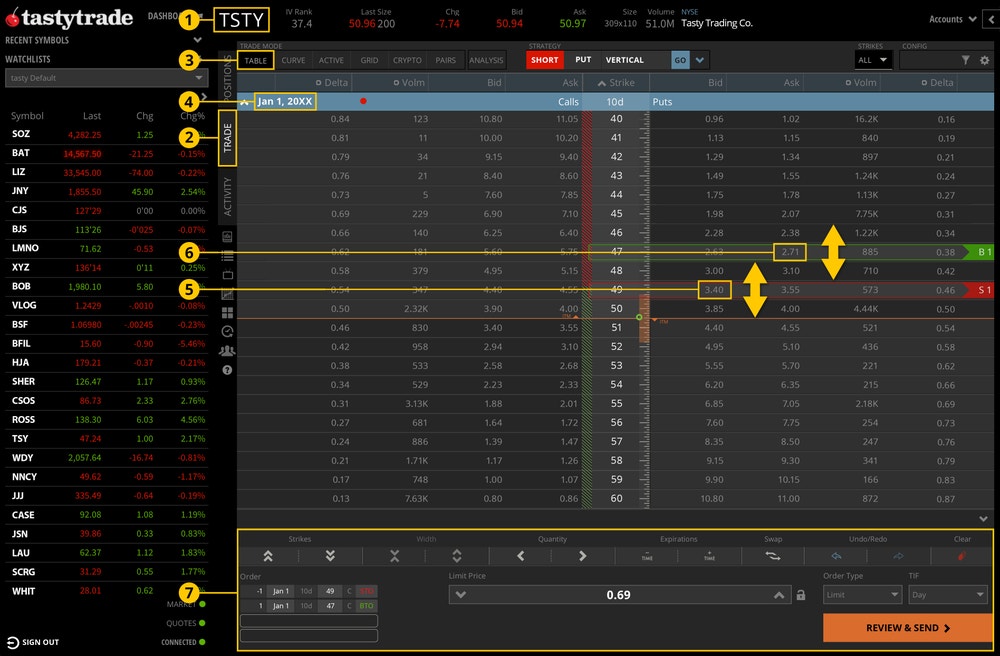Short Put Vertical Spread Options Strategy Explained
Short Put Vertical Spread Summary
- A short put vertical spread is a bullish position involving a short and long put with different strike prices in the same expiration.
- When setting up a short put spread, the short put is more expensive than the long put since the short put is closer to the money, resulting in a net credit.
- Buying a put at a lower strike price against the short put provides protection and reduces the maximum profit potential due to the cost of the long put.
- The credit received for the short put vertical spread is an investor's max profit if it expires OTM and is worthless at expiration.
- The max loss of a short vertical put spread is known upfront by subtracting the credit received from the spread width. However, losses can be more due to long stock assignment through the short put if the underlying closes and expires between the spread.
Short Put Vertical Spread
A short put vertical spread is a defined-risk bullish strategy where the trader wants the underlying price to rise. A short put vertical spread consists of two put option contracts in the same expiration: a short put closer to the stock price and a long put further out-of-the-money (OTM) than the short put. The long put that acts as a hedge in the same expiration. The short put is always more valuable than the long put in a short put vertical spread, resulting in a net credit the investor receives upfront after selling it. The goal is for the short put spread to lose value.

A defined risk spread is a strategy that caps your maximum loss potential. Max loss occurs when the underlying falls and breaches both legs of the short put vertical spread, causing both legs to go in-the-money (ITM) and trade at its full value, which is its spread width. When preparing a short put vertical spread order, you know what is at risk at order entry.
Compared to a short put on its own, one characteristic of a short put vertical is that the overall credit received is lower because it requires a long put to make it defined risk. In other words, you must pay for protection.
However, a potential benefit of defined-risk spread is that it requires a lower buying power requirement since we know the max loss ahead of time, which can be more capital efficient for accounts with limited buying power.
Like any other short options strategy, you will initially receive a credit when selling a put vertical spread. The value of the put spread will decrease when the underlying rises in price, which is exactly what you want for your short put vertical spread to be profitable to keep the credit.
Additionally, the value of a short put vertical spread can decrease over time when the price of the underlying remains constant, and the spread remains OTM due to time decay. The ideal scenario for a short put vertical spread is that the stock price remains above the short put strike at expiration and expires worthless by remaining OTM. When the entire short put spread expires OTM, a short put spread yields a maximum profit, less commissions and fees. The trade can also be “bought back” (covered) for less than the credit received upfront to yield a profit or bought back for more than the credit received upfront to realize a loss. In other words, the trade does not need to be held to expiration.
Conversely, the max loss scenario for a short put vertical spread is that it moves in-the-money (ITM). This happens if the stock price falls and trades below the long put strike. The spread can trade for a maximum value of the distance between the strikes, and the trader would have to buy back the spread to close the trade. At expiration, max loss would be realized in this case, or the trader can buy back the spread for potentially less than max loss before expiration if they choose to exit the position.
Expiration Risk for Short Put Vertical Spreads
A defined-risk vertical spread is no longer a defined risk position if one leg of the spread expires in the money, and the other does not. The risk lies with pin risk on the day of expiration, which is the risk surrounding the uncertainty of where the underlying will close to determine whether an option is in or out of the money. Options that expire in the money by $0.01 or more are auto-exercised, resulting in the short put option converting to 100 long shares of stock. In the case of a short put vertical spread, a partially ITM spread will convert to 100 long shares through short put assignment, and the OTM long put option would not get auto-exercised to offset the long shares [with short shares].
Additionally, any options strategy involving short options, including a short put vertical, may face after-hours risk on the day of expiration. In summary, although the vertical may have expired OTM based on the stock's closing print, an OTM short put option can become ITM based on any extreme downward price movement after the market close, resulting in an unexpected assignment of long shares. As a result, the investor would assume the risk of 100 long shares per contract assigned. The only way to eliminate after-hours risk is by closing any short options positions before expiration.
Due to the risk of getting assigned long shares, it's crucial to have a plan, like closing or rolling the position before expiration, to avoid this particular assignment risk, especially when the account does not have sufficient account equity to take on the resulting position. Please visit the tastytrade Help Center to learn more about expiration risk, including more about pin risk and after-hours risk.

Profit & Loss Diagram of a Short Put Vertical Spread
A short put vertical spread is a bullish trade that can yield a profit if the underlying remains above the short put strike until expiration, illustrated with a red P flag on the P/L diagram. As the share price rises or remains constant above the short put strike price, the value of the put credit spread can decrease over time depending on various factors such as changes in volatility or the velocity of the stock's price rise.
The initial credit received after selling a put vertical spread is an investor's max profit if it expires OTM and is worthless, as indicated where the green profit zone flattens above the x-axis.
Losses on the put credit spread occur when the underlying drops past the breakeven price, as illustrated where the green and red zones converge on the x-axis. As mentioned, defined-risk spreads are subject to expiration risk and are no longer defined risk if the underlying closes between the vertical spread.
Lastly, investors can experience their max loss potential on a short put vertical spread if it expires ITM entirely. However, the long put helps cap losses, as the green P flag indicates. As a result, the maximum loss on a short put vertical is the initial credit received minus the spread width, which the flattened red zone of the diagram illustrates.

What’s Required for a Short Put Vertical Spread?
Two put options in the same expiration.
- Sell to Open -1 short put
- Buy to Open +1 long put (any strike price below the short put)
Example of a Short Vertical Put Spread
XYZ currently trading @ $45
- -1 XYZ 40-strike put @ $4 credit
- +1 XYZ 35-strike put @ $2 debit
Collect a $2 credit ($200 total)
Spread Width: Short put strike – Long put strike = 40 – 35 = $5
Factor | Explanation |
|---|---|
Time Decay Affect | Works in your favor by decaying the value of the spread |
Max Profit | Total credit received |
Max Loss | Total credit received – (Spread width x 100) $200 total credit - ($5 x 100) = -$3 (-$300) |
Breakeven Price (at expiration) | Short strike price - Credit received $40 - $2 = $38 |
Buying Power Requirement | -$300 (max loss calculation) |
Account Type Required | Margin and IRA |
Other Names | Bull credit spread Put credit spread Short put spread Short put vertical |
Factor | Explanation |
|---|---|
Time Decay Affect | Works in your favor by decaying the value of the spread |
Max Profit | Total credit received |
Max Loss | Total credit received – (Spread width x 100) $200 total credit - ($5 x 100) = -$3 (-$300) |
Breakeven Price (at expiration) | Short strike price - Credit received $40 - $2 = $38 |
Buying Power Requirement | -$300 (max loss calculation) |
Account Type Required | Margin and IRA |
Other Names | Bull credit spread Put credit spread Short put spread Short put vertical |
How to Place a Put Vertical Credit Spread Order
Using the Strategy Menu
- Enter a symbol.
- Navigate to the Trade tab.
- Go to the Table mode.
- Click on an expiration date to expand.
- Click the Strategy Menu and locate the Vertical strategy. From left to right, click each column to display Short, Put, and Go.
- The long strike order will display a green bar, and the short strike will display in a red bar in the expanded expiration. Drag each strike up or down to the desired strike.
- Go to the order ticket to determine the quantity, price, time-in-force (TIF), etc. before clicking "Review & Send." Review everything including commissions and fees before sending the order.

Building it Manually
- Enter a symbol.
- Navigate to the Trade tab.
- Go to the Table mode.
- Click on an expiration date to expand.
- Click the Bid price of the short leg.
- Click the Ask price of the long leg.
- Go to the order ticket to determine the quantity, price, time-in-force (TIF), etc. before clicking "Review & Send." Review everything including commissions and fees before sending the order.

Options involve risk and are not suitable for all investors as the special risks inherent to options trading may expose investors to potentially significant losses. Please read Characteristics and Risks of Standardized Options before deciding to invest in options.
Multi-leg option strategies incur higher transaction costs as they involve multiple commission charges.